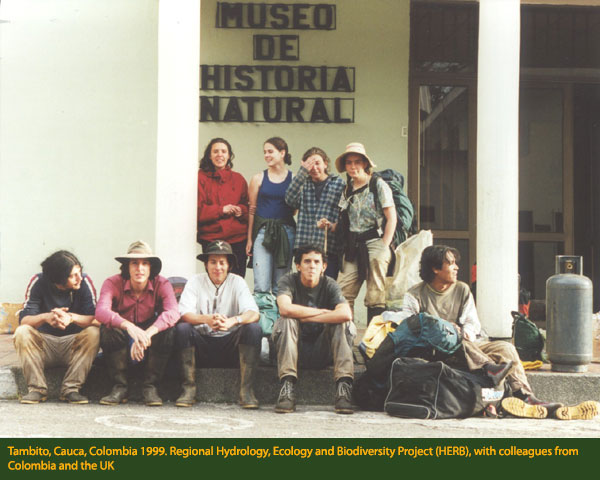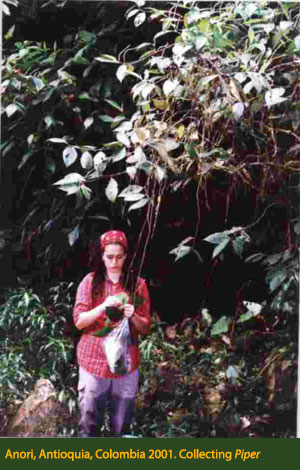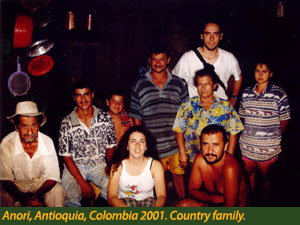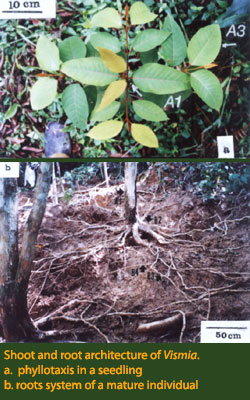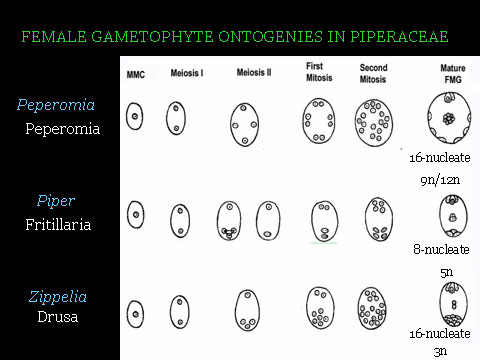Tatiana AriasBotany from a student's perspectiveUniversity of Missouri-Columbia, PhD Student
MY BOTANICAL STORY (so far)I learned to love biology and the natural world as a small child. I used to visit my father once a year in Bahia Solano, Choco, Colombia. There we spent our vacations exploring the jungle, and I made my decision to become a biologist because I wanted to know more about the biodiversity of my country. I applied to a public university, which is a highly competitive process in Colombia, and was admitted into the biology program at “La Universidad de Antioquia”, Medellin. I was involved in the university and activities related to school including teaching, research and discussion groups. I was among the top students in my department and I received honorable mentions for several semesters. I worked hard in my classes and suddenly biology became hugely fascinating to me. I shared a passion of biology with my best friends from college, and early in our careers we decided to focus on and learn everything we could about particular organisms. We formed study groups and explored Colombia looking for birds and reptiles, but eventually my interests gravitated toward plants.
The decision to study botany came when I took a plant morphology class with my former professor Ricardo Callejas, a world specialist for Piperaceae. I never will forget the passion with which he taught his classes and how exciting the thought of becoming a botanist was. I also got involved in the Student Association of Biological Sciences. We orchestrated meetings for students of biology in Colombia to showcase their research and we developed a collaborative project in Antioquia, Colombia with a network of reserves from the civilian society, focusing on conservation of natural resources. I participated as coordinator of the program protecting the marine turtle Dermochelis coriaceae, on the Atlantic side of the Colombian Choco and also took part in a project of regional hydrology, ecology, and biodiversity in Tambito, Cauca, Colombia. For the latter, a team of biology students from different parts of Colombia, together with several PhD students from King College in London, spent one month exploring the vegetation in the Tambito reserve. With this information, we completed the first part of a large-scale project modeling the biodiversity and monitoring conservation strategies in this area. In La Universidad de Antioquia I had the opportunity to be a teaching assistant for several classes including ecology, botany and plant morphology. This experience was very important in my career because through it, together with the influence of Ricardo Callejas, I decided that I not only wanted to continue research but that I would also like to teach. Through my studies, I had the opportunity to travel around my country and personally experience the difficult life of country people who were always willing to share the few things they had. Also, I saw the reality of the social conflict in Colombia and the necessity to improve education at many levels.
In the last year of my undergraduate career, I worked on a research project that I designed with the help of my advisor that investigated plant architecture of roots and shoots of Vismia (Hypericaceae). I spent six months uncovering root systems and describing them with the goal of applying the basic concepts of plant architecture to an unexplored system such as roots of tropical trees. I also wanted to understand ontogenetic processes and morphology of flowering plants. For the final part of my research I traveled to the Institute of Natural Sciences at the National University in Bogota, Colombia. I spent six months writing my thesis with Dr. Favio Gonzalez, a world specialist for Aristolochiaceae. Additionally I took several courses at the graduate level and participated in the theoretical biology group. To live in a different city, learning from professors in a different school and interacting with graduate students as colleagues was a very refreshing and rewarding experience.
After I finished my undergraduate degree, I obtained a scholarship to travel to Costa Rica to participate in the Tropical Plant Systematics Course offered by the Organization for Tropical Studies. In this course I interacted with biology students from Latin America, and I made contacts that eventually created an opportunity here in the US. I traveled to St. Louis in 2004 with a scholarship from the Missouri Botanical Garden. I did a project on the taxonomy of Manekia, a neotropical genus in Piperaceae with morphological characters very unique within the family. Additionally in this trip I visited Dr. Joe Williams at UT Knoxville. During my visit Dr. Williams invited me to stay and work as his lab technician while I applied to school. I collaborated with him on several of his projects and learned novel microscopy techniques. I then applied to UT’s Ecology and Evolutionary Biology department for my masters. I have been working at UT with Dr. Williams since the spring of 2005, and I intend to complete my M.S. in the spring of 2007. My master’s research was focused on the development and evolution of the female gametophyte and embryology in Manekia naranjoana. I was also working on some aspects of post-pollination events such as pollen tube germination and pollen tube growth, as well as early post-fertilization events. This research has been submitted to the American Journal of Botany for publication. I had two field seasons in Costa Rica doing pollination experiments in the canopy of a montane forest. While Manekia grows in my home country, the areas are very difficult to access and the civil war does not secure a good place to work, which is readily available in Costa Rica. At UT I was a teaching assistant in general botany for four semesters, and I have become comfortable teaching, learning and ultimately publishing in English.
I am currently about to start my doctorate at the University of Missouri-Columbia. I will be working with Dr. Alejandra Jaramillo in several aspects of the systematics, evolution and developmental biology of Piperaceae. CAREER GOALSMy general interest as a botanist is in the study of the origin of angiosperms, the role of development in evolutionary history of basal angiosperms groups, and the evolution of morphological characters in angiosperms. I am fascinated by the role of development in the evolutionary history of early angiosperm groups. My research goal is to take an integrative approach using the new, robust phylogenetic analysis with character evolution and developmental biology. More specifically, I would like to understand the role of development at different scales ranging from plant architecture to the female gametophyte structure. Additionally, I am interested in understanding how ontogenetic trajectories have been modified during evolution to alter the developmental patterns and processes, which ultimately may allow an explosion of diversification in early groups of angiosperms, such as Piperaceae.
RESEARCHPLANT ARCHITECTURE: plant architecture refers to the static morphological expression of the growth program of a plant at any time of its development. An architectural model is a dynamic concept that refers to the genetic blueprint which determines the successive architectural phases of a plant during its development.
I studied the architecture in roots and shoots of two species of Vismia (Hypericaceae) in a tropical rain forest, in Porce, Antioquia, Colombia. The shoot architecture of tropical trees has been studied in depth at different levels ranging from a morphological to an ecological perspective, while the root systems of tropical plants are virtually unknown. My research focused on unraveling and understanding architectural patterns in the shoot and root systems of two species of Vismia (V. baccifera and V. macrophylla). Vismia represents an excellent group of study because its species are early successional; they grow fast and the root systems are relatively shallow. I found a program of growth for shoots and roots that does not change among the individuals in the same developmental stage. However, some of the architectural features were quite plastic and vary according to specific requirements of the environment, especially in roots. This plasticity was morphologically expressed through ‘reiterations’, which are partial or total repetitions of the plant architecture, due to internal or external factors. Reiterations were common and their ontogeny was similar in both systems (shoots and roots). The architectural models for both shoots and roots were clearly different between each other. The evolutionary history of each system and the difference between environments in which they developed are responsible for the architectural variations found in each system. FEMALE GAMETOPHYTE DEVELOPMENT: the plant cycle of life comprises two alternating generations, the diploid sporophyte and the haploid gametophyte. In flowering plants the gametophytes are nutritionally dependent on the sporophyte and female gametophytes are retained into the floral tissues (sporophyte). During female gametophyte development a number of cells (or nuclei) that vary from 4 to 16 are produced through several round of mitosis. From this group of cells one haploid egg and a central cell with different ploidy levels (according to the species) are differentiated. Double fertilization in flowering plants occurs when there are two gametic fusion events that produced a diploid embryo (the fusion of the egg and sperm) and an endosperm with variable ploidy (the fusion of the central cell and a sperm nucleus). I have been studying the evolution of the female gametophyte in the tropical family of flowering plants Piperaceae for the last three years. Piperaceae offers a unique opportunity to examine the evolution of the female gametophyte development, because it is exceptionally diverse in the underlying female gametophyte ontogenetic patterns that produce variation in endosperms. My research reports the development of the female gametophyte of Manekia naranjoana, an undescribed member of Piperaceae. Manekia is tetrasporic with a 16-nucleate female gametophyte, however there was a great deal of ontogenetic variation. The evolutionary transition from monospory to tetraspory and from 8 to 16-nucleate female gametophytes in Piperales can be explained through heterochronic and heterotopic changes, and by additions and deletions in developmental sequences. Female gametophyte variation has consequences for the evolution of endosperm genetics.
Mission: The Botanical Society of America exists to promote botany, the field of basic science dealing with the study and inquiry into the form, function, development, diversity, reproduction, evolution, and uses of plants and their interactions within the biosphere.
|
